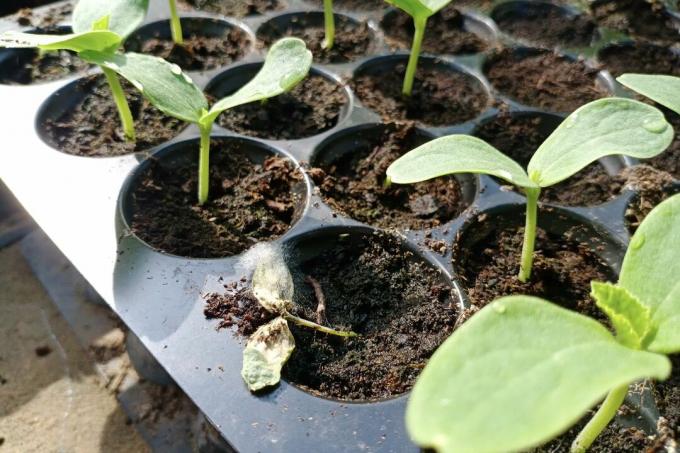Tip-over sickness: How you can recognize the damage, prevent fungal infestation and protect your seedlings.

contents
- Seedlings buckle, fall over and die
- Another cause of falling seedlings
- Preventive measures against falling sickness
- Fighting accidental sickness properly
Seedlings buckle, fall over and die
If your freshly sprouted seedlings suddenly droop or tip over, then a fungal infection could be responsible. Fall disease (syn.: emergence disease, black-leggedness, root burn, seed bed rot) is responsible for the falling over and subsequent shrinking of the young plants. A whole range of different fungal pathogens, such as Fusarium and Botrytis triggers this disease. If the seedlings lie completely on the ground and also have a sickly-looking stalk close to the ground, then the diagnosis is unfortunately very likely to be fallen sickness. The ailing area can look wrinkled, brownish or constricted. Warmth-loving crops such as tomatoes, cucumbers, basil and chilli are particularly often affected by the disease. By the way: the pathogens are also often able to grab cuttings.
Another cause of falling seedlings
In addition to the harmful fungi, there is often a completely different explanation for falling seedlings. This usually happens in spring, when the first vegetables are put on the windowsill for the gardening season. In poor light conditions, especially at the north window, the young plants then ginger. When it rains, the plant does not get enough sunlight and grows long in length. The whole growth force is then used for the stem growth. Affected plants have small cotyledons and at the same time a very soft and long shoot. For example, if a tomato seedling is on a windowsill with very little sunlight, the seedling will grow up until it tips over. Such plants are generally more susceptible and usually bend over completely after the first gust of wind. With a few precautionary measures, however, you can counteract the blooming: Wait until the sunny spring is really there before growing your young plants. Even if the seeds are too close, the small plants rob each other of valuable light. Incidentally, the gelation can also be slowed down with cool temperatures. Many young plants still feel good at 15 to 18 ° C. Seedling cultivation should therefore not take place in a warm living room (25 ° C) in poor lighting conditions. As a rule of thumb you can remember: the warmer a plant is, the more light it needs.

Preventive measures against falling sickness
Since infested young plants can hardly be saved, the focus should be on prevention. If some clues about the culture are taken into account, the falling sickness will no longer be a problem. Because the harmful mushrooms like a humid and at the same time warm environment, this combination should be avoided. The temperature has to be adapted to the needs of the seedlings and they usually like it warm too. Above all, the air humidity should be reduced again and again through regular ventilation. Many hobby gardeners literally ensnare their young plants. The young plants are often too much watered or constantly wetted with water from the spray bottle. Such a cultivation also provides mushrooms with optimal living conditions. So that the mushrooms stay away from our sensitive seedlings, we have put together a few tips for you:
- Stay away from the spray bottle! Plants, including young plants, do not have to be constantly wet. As a rule, most plants don't like constant moisture at all either.
- If you use a mini greenhouse for growing, don't forget to ventilate regularly. As a rule of thumb, the older the young plant, the more often and longer it should be aired. Unfortunately, there is no flat-rate ventilation period; a bit of tact and practice is required here.
- Ideally, the plants are only watered from below. Because on the one hand the plants stay dry and on the other hand the top layer of soil does not get too wet. There, on the top layer of the earth, many of the harmful fungi develop particularly well. It is also sufficient for the vast majority of young plants if the top layer of soil is slightly damp. Penetrating moisture only hurts here.
- The right choice of soil plays a role for seedlings that should not be underestimated. It is generally recommended to use potting soil such as ours Plantura organic herb & seed compost to use. It is low in germs and nice and loose, which means that excess water can drain off quickly (this is of course only possible with existing drainage holes!). If you want to be on the safe side, you can also steam your soil to kill possible fungal pathogens. This works in the microwave and takes approx. 15 minutes or you can put the soil in the oven for 30 minutes and 200 ° C. So that the damping also promises success, the soil must not be dry during the sterilization process.

Fighting accidental sickness properly
It would be nice if infected seedlings could still be saved, but this is not the case. The small plants are still far too sensitive to regenerate after a fungal attack. For this reason, you should remove sick young plants immediately so that the fungal disease cannot spread any further. As a precaution, it is better to sow a few more seeds, then you can live well with the loss of a few young plants.



